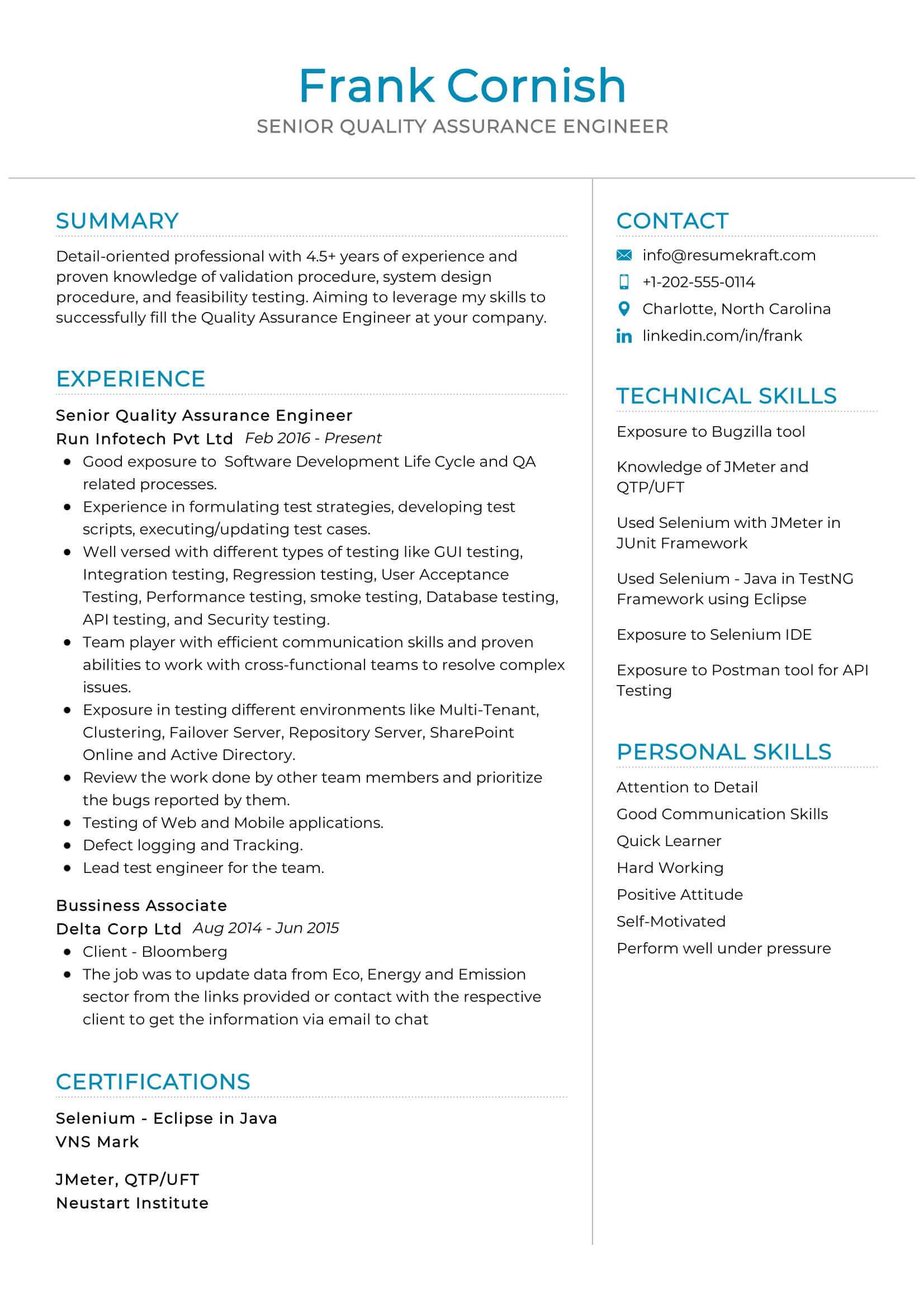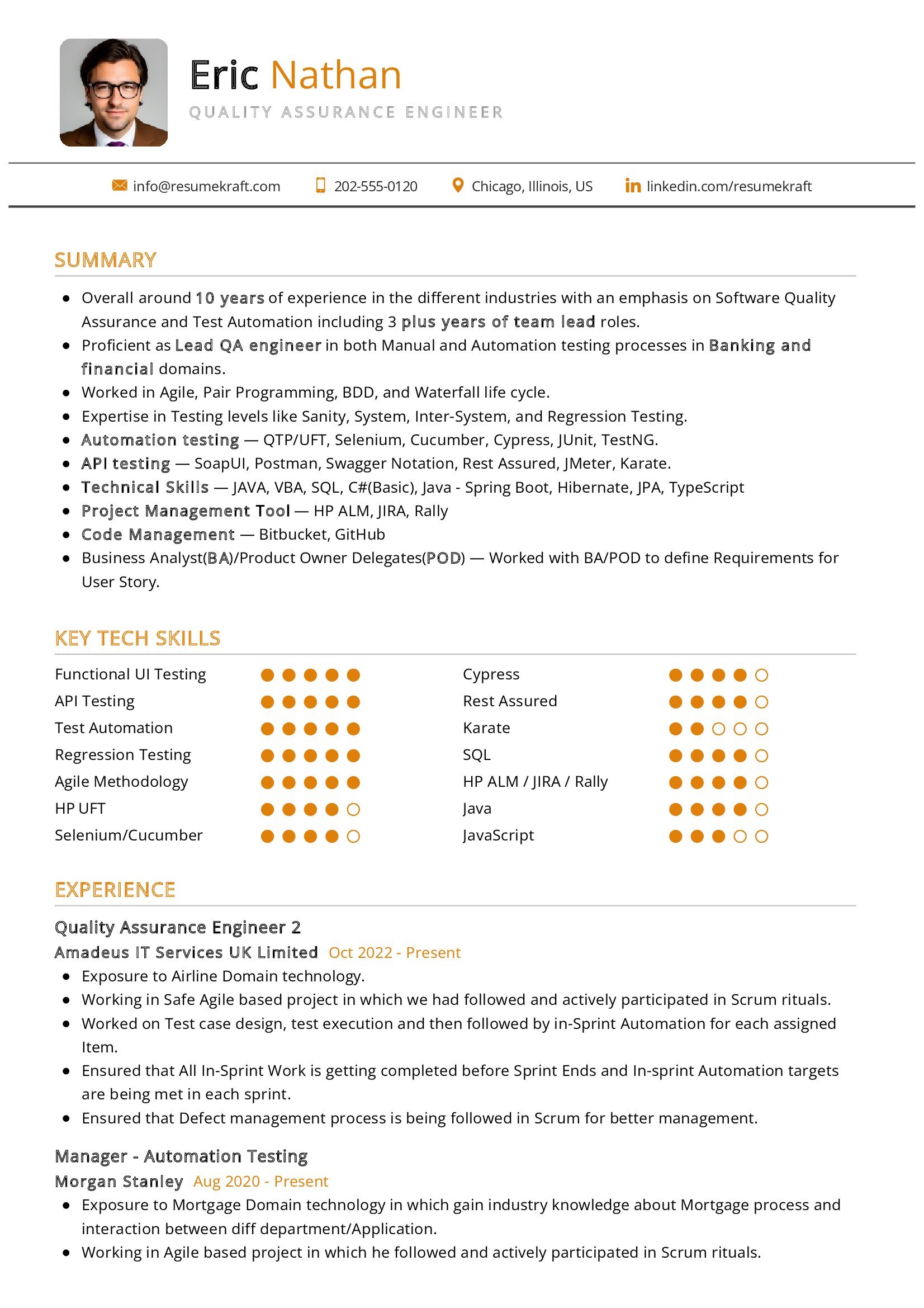How To Craft An Impressive Quality Assurance Resume That Stands Out
Hey there, job hunter! Let’s talk about something super important—your quality assurance resume. If you’re aiming to land your dream QA role, your resume needs to be more than just a list of your experiences. It’s your golden ticket to getting noticed by hiring managers who are scrolling through piles of applications every day. Are you ready to level up your resume game? Let’s dive in!
Creating a standout resume is not as hard as it seems. You just need to know the right tricks, strategies, and formatting that’ll make your skills and achievements pop. In this guide, I’ll spill all the secrets you need to build a resume that doesn’t just get noticed—it gets results.
Think of your resume as your personal sales pitch. It’s your chance to highlight why you’re the best candidate for the job. Whether you’re a seasoned QA professional or just starting out, this guide will help you craft a resume that screams "hire me!" So grab your favorite drink, and let’s get started!
Understanding the Importance of a Quality Assurance Resume
Let’s face it—quality assurance is more than just testing software. It’s about ensuring that products meet the highest standards and deliver value to users. But how do you showcase your skills and accomplishments in a way that resonates with hiring managers? That’s where a well-crafted resume comes in.
A quality assurance resume is your first impression. It’s the document that decides whether you’ll get that all-important interview call or end up in the "no" pile. The competition in the QA field is fierce, so you need to bring your A-game to stand out. Think of it this way: if you don’t nail your resume, you’re leaving money on the table—or worse, letting someone else take the job you deserve.
Key Components of a Winning QA Resume
Now that we’ve established why a strong resume matters, let’s break down the key components you need to focus on:
- The Ultimate Guide To Disney Character Personalities
- The Complete Guide To Talisua Fuavaifatu Age Unlocking Its Secrets
- Professional Summary: A brief overview of your skills, experience, and accomplishments.
- Technical Skills: Highlight your expertise in tools, languages, and methodologies relevant to QA.
- Work Experience: Showcase your roles, responsibilities, and achievements in previous QA positions.
- Education and Certifications: List your academic background and any relevant certifications.
- Projects and Contributions: Include any notable projects or contributions that demonstrate your impact.
Each of these components plays a crucial role in painting a complete picture of your qualifications. Let’s explore them in more detail below.
How to Write a Compelling Professional Summary
Your professional summary is like the hook in a great story—it needs to grab attention right away. This section should be concise yet impactful, giving hiring managers a snapshot of who you are and what you bring to the table.
Here’s how to write a compelling professional summary:
- Start with a strong opening sentence that highlights your years of experience or key expertise.
- Mention your core strengths, such as automation testing, manual testing, or quality control.
- Include measurable achievements that demonstrate your impact in previous roles.
- Tailor your summary to the specific job you’re applying for, using keywords from the job description.
For example:
"Dynamic Quality Assurance professional with 5+ years of experience in manual and automation testing. Proven track record of reducing defect rates by 30% and improving software quality through rigorous testing methodologies. Skilled in Selenium, JIRA, and TestNG, with a focus on delivering high-quality products on time."
Why a Professional Summary Matters
Hiring managers often spend less than 10 seconds reviewing a resume. A well-written professional summary can make or break your chances of getting noticed. It’s your opportunity to make a strong first impression and convince recruiters that you’re worth a closer look.
Highlighting Your Technical Skills
As a QA professional, your technical skills are your bread and butter. Recruiters want to see that you’re proficient in the tools and technologies relevant to the role. But don’t just list your skills—show how they’ve helped you achieve results.
Here are some tips for highlighting your technical skills:
- Use bullet points to make your skills easy to scan.
- Include both hard skills (e.g., Selenium, Python) and soft skills (e.g., problem-solving, attention to detail).
- Mention any certifications or training you’ve completed, such as ISTQB or CSTE.
- Quantify your achievements where possible, such as "Developed 100+ automated test scripts using Selenium, reducing testing time by 40%."
Example:
- Proficient in Selenium, TestNG, JIRA, and Jenkins
- Experienced in writing and executing test cases for both manual and automated testing
- Strong knowledge of SQL and database testing
Common Tools and Technologies in QA
Here’s a quick rundown of the most in-demand tools and technologies in the QA field:
- Test Automation Tools: Selenium, Appium, TestComplete
- Defect Tracking Tools: JIRA, Bugzilla, HP ALM
- CI/CD Tools: Jenkins, Travis CI, CircleCI
- Programming Languages: Python, Java, JavaScript
Make sure to include any tools or languages you’re familiar with, even if they’re not explicitly mentioned in the job description. You never know what might catch a recruiter’s eye!
Detailing Your Work Experience
Your work experience is where you get to shine. This section should provide a detailed account of your roles, responsibilities, and accomplishments in previous QA positions. But don’t just list your duties—focus on what you achieved.
Here’s how to detail your work experience:
- Use action verbs to describe your responsibilities (e.g., "Designed," "Implemented," "Optimized").
- Include measurable results wherever possible (e.g., "Improved test coverage by 25%").
- Tailor your experience to the job description, emphasizing the skills and achievements that align with the role.
Example:
Quality Assurance Engineer | Tech Solutions Inc.
June 2018 – Present
- Designed and executed comprehensive test plans for web and mobile applications, ensuring compliance with industry standards.
- Automated 80% of regression testing using Selenium, reducing manual testing time by 35%.
- Collaborated with cross-functional teams to identify and resolve critical defects, improving product quality by 20%.
How to Make Your Experience Stand Out
Don’t be afraid to go beyond the basics. Include any side projects, volunteer work, or open-source contributions that demonstrate your passion for QA. Recruiters love to see candidates who are proactive and committed to their craft.
Education and Certifications
While experience is king, education and certifications can give you a competitive edge. List your academic background and any relevant certifications that showcase your expertise in QA.
Here’s how to format your education section:
- Include your degree, major, and institution name.
- Mention any honors or awards you received during your studies.
- List certifications in a separate section, including the certification name and date obtained.
Example:
Bachelor of Science in Computer Science | XYZ University | Graduated: May 2017
Certified Tester Foundation Level (CTFL) | ISTQB | Obtained: January 2020
Why Certifications Matter
Certifications validate your skills and demonstrate your commitment to professional development. They can also help you stand out in a crowded job market. Some of the most sought-after QA certifications include:
- ISTQB Certified Tester
- CSTE (Certified Software Tester)
- CSQA (Certified Software Quality Analyst)
Projects and Contributions
Projects and contributions are a great way to showcase your practical skills and real-world experience. Include any notable projects you’ve worked on, whether they’re personal, professional, or open-source.
Here’s how to highlight your projects:
- Provide a brief description of the project and your role in it.
- Mention the tools and technologies you used.
- Include measurable outcomes or achievements.
Example:
Automated Testing Framework for E-commerce Platform
- Developed a custom automation framework using Selenium and TestNG, reducing testing time by 40%.
- Implemented data-driven testing to handle multiple test scenarios, improving test coverage by 25%.
Why Projects Matter
Projects give recruiters a glimpse into your problem-solving abilities and technical expertise. They also demonstrate your ability to work independently and contribute to team success.
Formatting and Design Tips
Your resume’s formatting and design can make a big difference in how it’s perceived. Here are some tips to make your resume visually appealing and easy to read:
- Use a clean, professional layout with plenty of white space.
- Stick to one or two fonts, and use bolding or italics sparingly.
- Limit your resume to one or two pages, depending on your experience.
- Use bullet points to break up long paragraphs and make information scannable.
Remember, your resume should be easy on the eyes and easy to navigate. Don’t let poor formatting distract from your qualifications.
Common Formatting Mistakes to Avoid
Here are some common formatting mistakes to avoid:
- Using overly complex fonts or colors
- Cramming too much information onto one page
- Forgetting to proofread for typos and grammatical errors
Final Tips for Success
Before you hit send on that job application, here are a few final tips to ensure your resume stands out:
- Tailor your resume to each job application, using keywords from the job description.
- Ask a trusted friend or mentor to review your resume for feedback.
- Use online tools like Grammarly to catch any typos or grammatical errors.
And remember, your resume is just the beginning. Once you land that interview, it’s time to show off your skills and personality in person. Good luck!
Conclusion
Crafting an impressive quality assurance resume takes time, effort, and a bit of creativity. But with the right strategies and tips, you can create a resume that not only stands out but also lands you your dream job. Remember to focus on your strengths, accomplishments, and relevant skills—and don’t be afraid to showcase your passion for QA.
So what are you waiting for? Start building your resume today and take the first step toward a successful QA career. And hey, if you found this guide helpful, don’t forget to share it with your fellow job hunters. Let’s help each other succeed!
Table of Contents
- Understanding the Importance of a Quality Assurance Resume
- How to Write a Compelling Professional Summary
- Highlighting Your Technical Skills
- Detailing Your Work Experience
- Education and Certifications
- Projects and Contributions
- Formatting and Design Tips
- Final Tips for Success
- Conclusion
- 5movierulz 2023 Download Your Ultimate Guide To Movie Streaming And Downloads
- The Meaning Of Ethical Nonmonogamy Enm Relationships

Quality Assurance Resume Examples & Templates (2025) · Resume.io

Senior Quality Assurance Engineer Resume in 2025 ResumeKraft

Quality Assurance Engineer Resume Sample in 2025 ResumeKraft